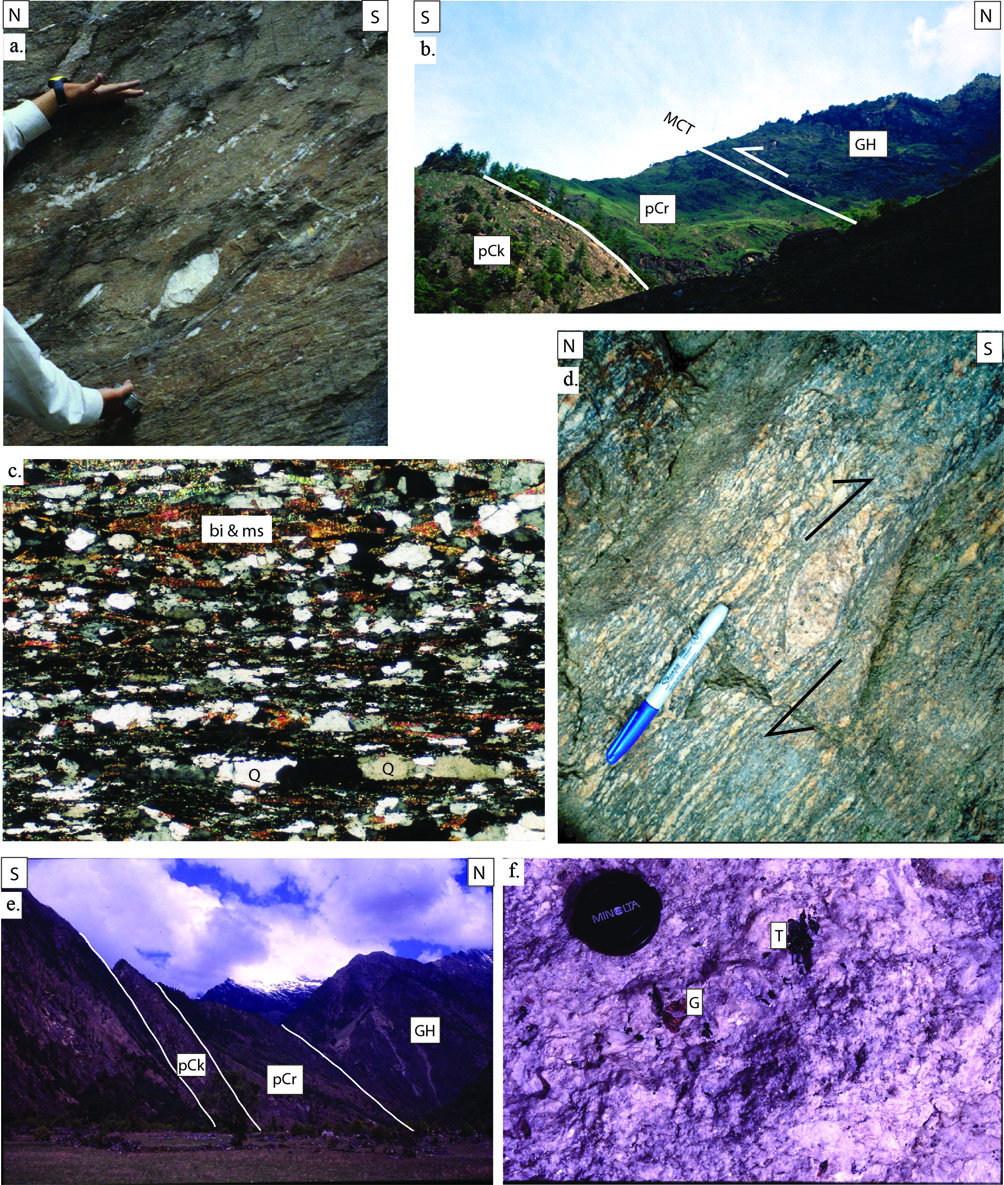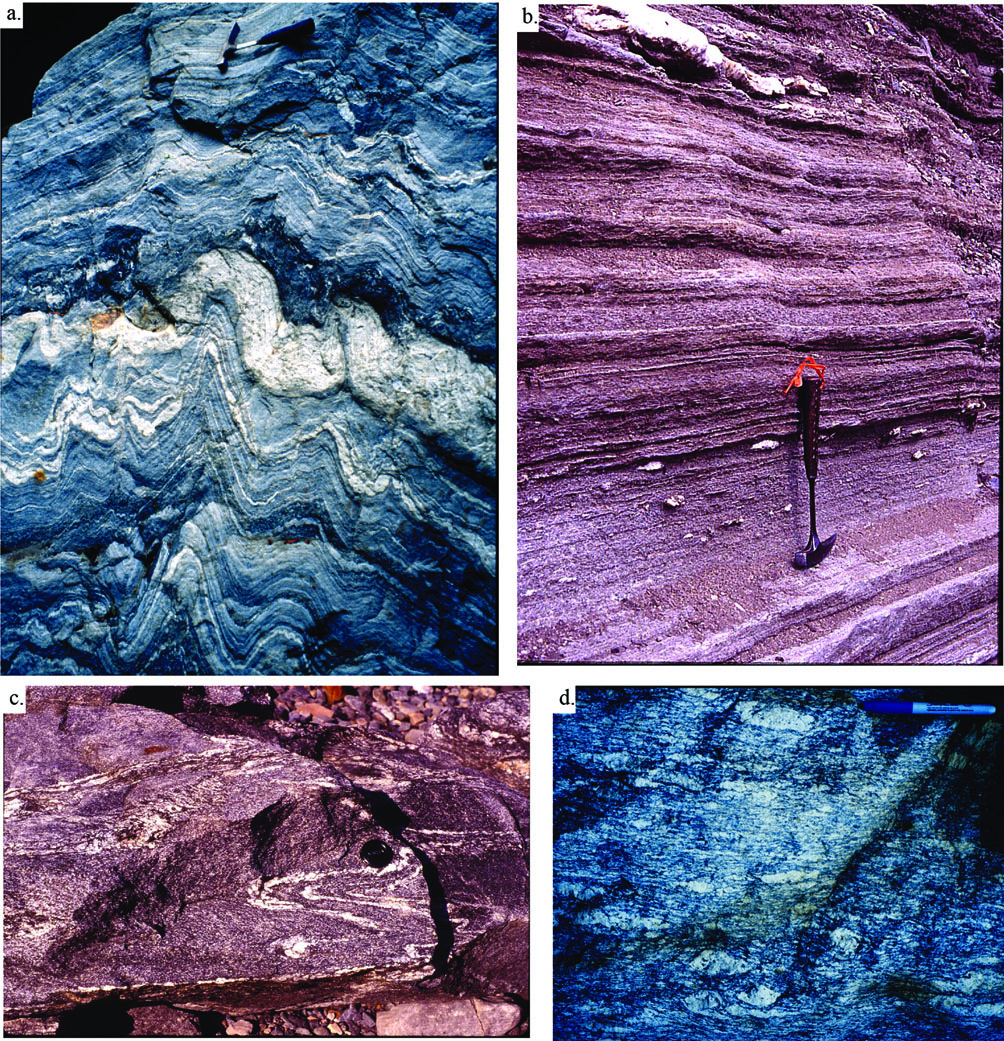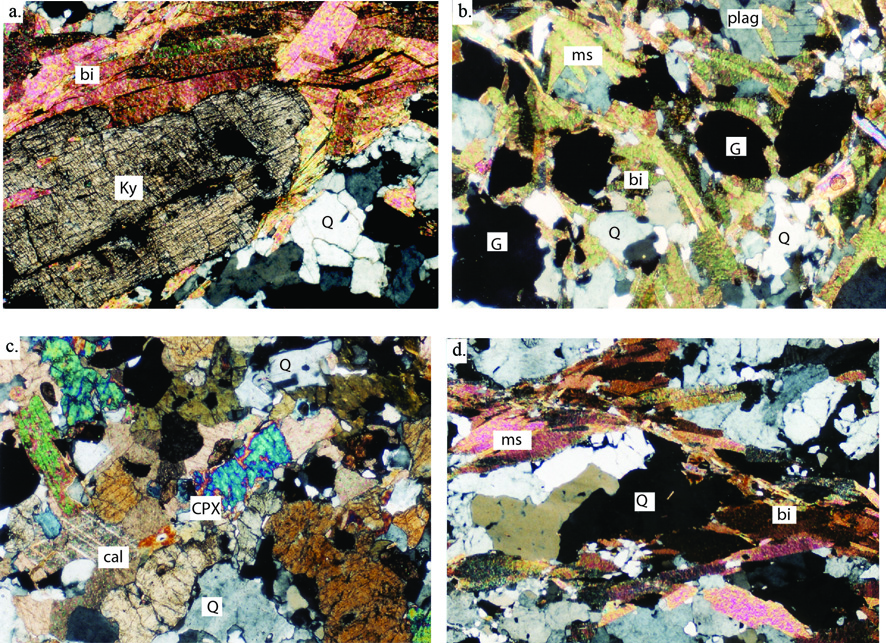DAY 10. Northern Lesser Himalayan Duplex and Main Central Thrust
From Ghat Khola, return to the Seti River. Choose the lowest trail near the river because it has excellent exposures of the Ranimata Formation and mafic intrusions into the phyllite/schist, and the fault contact between Ranimata and Kushma formations, the RMT (Figs. 13 c-f; N29º45’33; E81º17’28.2”; 2125 m). On the way to the village of Dhuli, there are several repetitions of the Ranimata and Kushma Formations (Figs. 2, 3b). At Dhuli, the Ranimata Formation is a garnet-white mica-chlorite schist (Figs. 14 a-d)(SR103a; N29º46’29.2; E81º16’47.4”; 2534 m) with coarse-grained intrusive mafic rocks and rare carbonate interbeds. The Kushma Formation within the LH duplex horses has rare kyanite (Fig. 14f). To the north of Dhuli, the Ranimata Formation is more biotite- and garnet-rich, and the top-to-the-south sense of shear becomes more prominent (Fig. 15a).
Greater Himalayan rocks north of the Main Central thrust
Formerly, GH rocks have been regarded as Indian cratonic basement (e.g. Gansser, 1964; Mattauer, 1986; Srivastava & Mitra, 1994; Hauck et al., 1998). Several studies, however, show these rocks had Neoproterozoic and lower Paleozoic sedimentary protoliths and are nothing like cratonic India (Parrish & Hodges, 1996; Whittington et al., 1999; DeCelles et al., 2000; Ahmad et al., 2000; Robinson et al., 2001). Figure 15b is a picture of the MCT in Ghat Khola separating LH from GH rocks. The contact between the two lithotectonic zones exhibits extreme shear strain (Figs. 15 c-d) and is located approximately 40 m north of N29º47’04.3”; E81º15’38.6”; 2554 m on the Seti River (Fig. 15e). Within the GH rocks are younger (15-20 Ma) leucogranite bodies that are decompression melts formed during exhumation of the GH rocks (Fig. 15f) (Harris & Massey, 1994; Visonà & Lombardo, 2002; Visonà et al., 2012).
Figure 15. Ranimata Formation and the MCT

(a) Deformation in the LH Ranimata Formation in the immediate footwall of the MCT. Quartz auge shows a top to the south sense of shear (N29°47’ 12.2”; E81°15’ 42.3”; 8126±267’). (b) The RMT sheet and the MCT along the Ghat Gad. The lower cliff is composed of Kushma Formation quartzite (pCk). The recessive rock above the quartzite is the Ranimata Formation (pCr). The MCT separates the Ranimata Formation from the resistant GH rocks above (N29°44’ 50”; E81°23’ 10.4”; 7453±129’). (c) Photomicrograph of a highly strained rock in the “MCT zone”. Mineral abbreviations are the same as those used in Figure 14. Field of view is ~4.5 mm on the vertical. (d) Rotation of a feldspar auge in unit III of the GH. The auge shows top-to-the-south sense of shear. Pen is ~8 cm long. (e) The position of the MCT across the Seti River toward the NW from the village of Dhuli. The fault zone is indicated by the white line separating pCr from GH. (f) Garnet and tourmaline-bearing two mica leucogranite, exposed north of Dhuli in the GH. (T) tourmaline, (G) garnet. Lense cap is 5 cm in diameter.
In western Nepal, the GH rocks can be subdivided into three informal units (units I, II, and III; Fig. 2) first recognized in central Nepal (Le Fort, 1975; Le Fort, 1994; Colchen et al., 1986) (Figs. 16, 17). More specific descriptions of the GH rocks and shear zones are in Montomoli et al. (2013) and Carosi et al. (2010). Unit I consists of garnet- and kyanite-bearing pelitic gneiss, migmatite, and abundant metaquartzite with a middle- to upper- amphibolite facies metamorphic grade (Fig. 16a, 16c). The gneissic mineral assemblage includes quartz + biotite + muscovite + plagioclase + garnet ± kyanite ± cordierite ± epidote ± zircon (Figs. 17a, 17b). The metaquartzite contains quartz + muscovite + biotite ± plagioclase.
Within what we have mapped as unit I (~6 km thick) are thin (meters to tens of meters thick) lenticular bodies of diopside-, garnet-, phlogopite-, amphibole-bearing calcsilicate gneiss and marble (Fig. 16b). These thin bodies, if larger, would be mapped as unit II in other parts of Nepal. However, because these bodies are not mappable at the scale presented, we group them within unit I. Mineral assemblages in the calcsilicate gneiss (unit II) include calcite + quartz + potassium feldspar + plagioclase + hornblende + clinopyroxene ± sphene (Fig. 17c). Alternating layers of silicate minerals and calcite impart a “washboard” weathering habit to unit II (Fig. 16b).
Unit III contains mainly augen orthogneiss with a penetrative schistosity delineated by biotite and muscovite (beginning at N29º49’26.1”; E81º16’0.2”; 2652 m) (Fig. 16d). The mineral assemblage includes quartz + plagioclase + potassium feldspar + biotite + muscovite + garnet ± zircon ± apatite (SR 115) (Fig. 17d). Porphyroblastic feldspars are stretched and rotated with a top-to-the-south sense of shear. Similar orthogneiss bodies from other parts of the Himalaya yield Cambrian-Ordovician ages (e.g. Frank et al., 1977; Ferrara et al., 1983; Le Fort et al., 1983; LeFort, 1986; Pognante et al., 1990; Parrish & Hodges, 1996; Gehrels et al., 2003; 2006).
Camp this night is at the confluence of the Seti and Liyangwan Rivers (N29º49’55”; E81º15’15.3”; 2713±150 m) (Camp 10 on Fig. 2).
Figure 16. GH units

(a) Migmatitic banding in unit I of the GH. Rock hammer is 0.3 m long. (b) Strongly foliated calcite-pyroxene marble north of Dhuli in the GH unit 2. Rock hammer is 0.3 m long. (c) Migmatitic black biotitic gneiss, GH unit 1 north of Dhuli. Lens caps is 5 cm in diameter. (d) GH unit III augen gneiss.
Figure 17. Photomicrographs of Greater Himalayan rocks

Photomicrographs of Greater Himalayan rocks north of Dhuli. (a) GH Unit I, large kyanite (Ky) crystal surrounded by biotite (bi), muscovite (ms) and quartz (Q). Field of view is ~4.5 mm. (b) GH Unit I, Garnet (G) porphyroblasts surrounded by biotite, plagioclase feldspar (plag). Field of view is ~4.5 mm. (c) GH Unit II, calcite (cal), clinopyroxene (CPX). Field of view is ~4.5 mm. (d): GH Unit II, schistosity is defined by the biotite and muscovite bands. Field of view is ~9 mm.